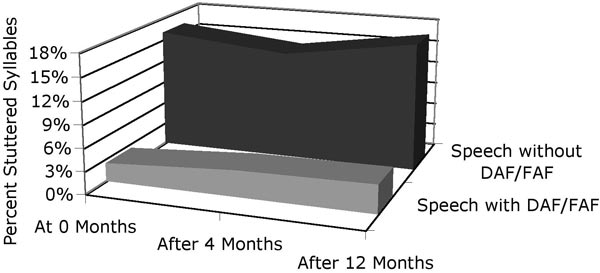Speech-Language Pathology/Stuttering/SpeechEasy
- Anti-stuttering technology: DAF, FAF (frequency compression/expansion).
- Hearing aid-size.
- Special features:
- Frequency range: 200-7000 Hz.[1]
- Monaural (one ear).
- Anti-background noise features: high-frequency filter, voice activation (EVAT), dynamic expansion (INAS).
- Website: http://www.speecheasy.com
Efficacy Studies
[edit | edit source]- Thirteen adult stutterers were tested using the SpeechEasy anti-stuttering device for reading, monologue, and conversation. On average stuttering was reduced 36%, however, the effectiveness "varied greatly across participants." The subjects were then given speech therapy (training vowel prolongation) and the combination of therapy and the device reduced stuttering 53%.[2]
- Nine stutterers used a DAF/FAF device about seven hours per day. Their fluency was measured after four months and after twelve months.[3] [4] The delay was set at 60 milliseconds and the frequency compression FAF at 500 Hz up. The subjects received brief speech therapy, specifically to prolong vowels and use "starter sounds" such as "um" and "ah." The device reduced stuttered syllables about 80%. The users had no statistically significant carryover fluency.

- An unpublished study[5] found that SpeechEasy devices were effective for reading aloud but not effective in conversations.
An unpublished study[6] raised questions about whether the devices in the study “wore off” or lost effectiveness over time. Only the data from the study are available, not the written explanation of the results, so the following may be a misinterpretation of the results.
18 adults and one child tried SpeechEasy devices. The DAF and FAF settings weren’t provided in the results. Of these nineteen subjects, twelve (63%) had excellent initial results, with 1% or less stuttering (the results don’t say whether this was % stuttered words or syllables). Two subjects (11%) experienced no improvement in their speech. On average, the devices reduced stuttering initially about 75%.
Nine subjects purchased the devices, seven didn’t purchase them, two purchased and then returned the devices, and one purchase was “pending.” The nine who purchased were re-evaluated an average of seven months later. Four continued to have excellent speech (1% or less stuttering). One person who had only good results initially now had excellent results (an improvement over six months). One person who had excellent results initially now had only good results. Two others had speech worse than before using the device. On average, the devices now reduced stuttering about 57%.
Six subjects returned for a second follow-up, on average of eighteen months after purchasing the devices. Two subjects were stuttering about as much as before they purchased the device. The other four subjects were worse. On average, the device now increased stuttering about 50%.

Five subjects were tested at a third follow-up. They averaged 30 months using the device. One subject appears to have better speech after 30 months than before using the device (his stuttering dropped from 30% to 17%). Four subjects appear to have worse speech after 30 months than before using the device. Two of these were slightly worse (e.g., stuttering increased from 12% to 13%), one was moderately worse, and one had substantially worse speech (stuttering went from 2% to 9%). Adding the three additional subjects who were tested at the second follow-up but not the third follow-up, this study raises questions of whether seven of eight SpeechEasy users had worse stuttering after long-term use of the device.
References
[edit | edit source]- ^ Stuart, A., Xia, S., Jiang, Y., Jiang, T., Kalinowski, J., Rastatter, M. "Self-contained in-the-ear device to deliver altered auditory feedback: applications for stuttering," Annals of Biomedical Engineering, 31, 233-237, 2003.
- ^ Armson, J., Keifte, M., Mason, J., De Croos, D. "The effect of SpeechEasy on stuttering frequency in laboratory condition," Journal of Fluency Disorders 31 (2006) 137-152.
- ^ Stuart, A., Kalinowski, J., Rastatter, M., Saltuklaroglu, T., Dayalu, V. "Investigations of the impact of altered auditory feedback in-the-ear devices on the speech of people who stutter: initial fitting and 4-month follow-up," International Journal of Language and Communication Disorders, 2004, 39:1, 93-113.
- ^ Stuart, A., Kalinowski, J., Saltuklaroglu, T., Guntupalli, V. "Investigations of the impact of altered auditory feedback in-the-ear devices on the speech of people who stutter: One-year follow-up," Disability and Rehabilitation, 2006. 1-9.
- ^ Pollard, R., Ellis, J.. Ramig, P., Finan, D. A longitudinal study of the effects of the SpeechEasy device in naturalistic environments. presentation to American Speech-Language Hearing Association convention, November 2006.
- ^ Runyan, C., Runyan, Sara. "The Speech Easy: A Two Year Study," presentation to American Speech-Language Hearing Association convention, November 2005.
Personal Experiences Using SpeechEasy Devices
[edit | edit source]Please read Speech-Language Pathology/Stuttering/How to Participate in this Wikibook before adding material to this section.
- User discussion board on SpeechEasy website


